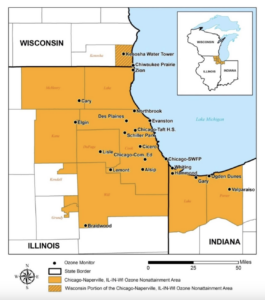ELPC Attorney Mike Zoeller testifies to IDEM
July 10, 2023
ELPC Joins Northwest Indiana Residents Calling on Indiana to Reduce Smog
By ELPC legal intern Jada Williams
State agency plans to adopt no new control measures to reduce ozone concentration levels in an area plagued by unhealthy air quality. Locals demand Indiana do more to protect public health.
This summer, the Indiana Department of Environmental Management (IDEM) released an insufficient new plan to address ozone pollution in northern Lake and Porter counties. ELPC submitted technical comments highlighting the shortcomings of the plan, which will leave locals vulnerable to pollution, and we urged the agency to host a public hearing. Within just two days’ notice, dozens of residents showed up to speak about how ozone pollution affects their communities and urge the Indiana Department of Environmental Management to step up its efforts for cleaner air.
Ozone and The Chicago Nonattainment Area

Chicago IL-IN-WI nonattainment area
Ground-level ozone, most commonly known as smog, is one of the six most regulated criteria air pollutants. The United States Environmental Protection Agency (EPA) sets National Ambient Air Quality Standards (NAAQS) for these six, which are used to specify the maximum allowed measurement of each pollutant to be present in outdoor air. Smog is formed when nitrogen dioxide (NOx) and volatile organic compounds (VOCs) are emitted from cars, power plants, industrial boilers, refineries, chemical plants, and other sources and react with each other in the presence of sunlight. Exposure to smog can have negative health impacts, including causing breathing difficulties, inflammation and damage to airways, aggravating lung diseases like asthma, and increasing the frequency of asthma attacks.
Most of the Chicago IL-IN-WI metropolitan area was designated as “marginal” nonattainment for ozone concentrations in June 2018, and it was given a 3-year period to reduce ozone concentrations. After failing to meet its August 2021 deadline for ozone attainment, the area was reclassified as “moderate” nonattainment in October 2022, with a final attainment date set for August 3, 2024.
IDEM’s Draft Attainment Demonstration and ELPC’s Comments

ELPC Attorney Mike Zoeller testifies to IDEM
As a result of EPA’s reclassification of the Chicago nonattainment area, the Clean Air Act requires IDEM to demonstrate how it will improve air quality. In its latest plan, known as an Attainment Demonstration, IDEM concluded that no new control measures were needed to bring the area into attainment because ozone concentrations were already declining, and no new control measures could help the area reach attainment by the August 3, 2024 deadline.
ELPC’s comments highlighted increasing ozone levels measured in northern Lake and Porter Counties and urged IDEM to reassess its hands-off strategy and challenged the modeling and data used that supported its conclusion. Notably, ELPC requested that IDEM do more to regulate the lakeshore industries that are a significant source of the pollution. The full comments can be found here.
The Public’s Response to the Attainment Demonstration
Once ELPC submitted its comments to IDEM, senior attorney, Mike Zoeller, circulated them to citizens in Northwest Indiana. At the request of ELPC and other concerned community members, a public hearing was requested and scheduled for June 28, 2023. Despite receiving only two days’ notice of the public hearing, over 20 people attended, including Northwest Indiana residents and ELPC staff, to raise concerns about the Attainment Demonstration and air quality. Over half of the Northwest Indiana residents in attendance provided oral comments to IDEM representatives, urging the agency to reconsider its position in the Attainment Demonstration and take more action to reduce the smog in the area.
“We’re not technicians, we’re not engineers. We’re people living in this toxic stew.” – Northwest Indiana Resident Testimony
Many community members raised concerns about the health of those, particularly the children, living in the nonattainment area and shared powerful stories of how the air pollution in Northwest Indiana was correlated to adverse health effects. Multiple parents gave testimony of their children having to spend days of summer indoors instead of playing outdoor sports and attending summer camps because of the poor air quality of the region. Tales of frequent emergency room visits, children born prematurely, children developing asthma, and longtime residents developing cancer hammered home the community’s cry that IDEM had to “do better” to ensure that the people in Northwest Indiana could breathe clean air.
“We’re talking about a crisis here … when does it end?” – Northwest Indiana Resident Testimony
It was clear that the residents of Northwest Indiana were displeased with IDEM’s proposed course of action. In addition to sharing personal stories, some speakers offered suggestions for IDEM to consider as control measures. These suggestions included incentivizing citizens to drive hybrid and electric vehicles, being stricter on industry and holding polluting facilities to a higher standard, and working collaboratively with other state departments and experts to develop long-lasting solutions. This showed that Northwest Indiana citizens are not only concerned with the air quality of the Region but that they desire to partner with IDEM and be part of the solution.
What’s Next
IDEM is required to provide responses to the written and oral comments provided about the Attainment Demonstration. ELPC and the Northwest Indiana community hope that IDEM will take the comments seriously, strengthen its attainment plan, and ensure healthy air in the Region.

